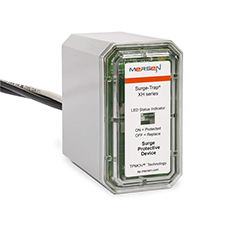
Know the Devices That Do – and Don’t – Meet NEC’s New Surge Protection Requirements
Chuck Ross
Whole-home surge protection has become a much bigger issue for residential electrical contractors in the last year as local authorities have begun adopting the 2020 edition of the National Electrical Code (NEC). This latest NEC revision now requires Type 1 or Type 2 surge protection devices (SPDs) be installed when new electrical service is installed or major service upgrades or panel replacements occur. This change recognizes the greater use of sensitive electronics throughout the home, including in appliances like ranges and refrigerators.
Contractors and distributors might still be working through the details of these new mandates, so a brief refresher on the three types of surge suppression might be in order.
Type 1
These SPDs are rated for installation before or after a main breaker, but they’re more often used on the line side of the breaker to help prevent against surges that might occur due to lightning or utility activities (like power returning after an outage). Because of this capability, they can be used to replace secondary surge arrestors or lightning arrestors.
Type 2
These are the more common type of SPD for residential applications. They’re installed on or adjacent to the main electrical panel. While they might help mitigate some of the damage potential of a nearby lightning-based surge, they’re larger function is to protect against smaller surges that can be generated within a home when, say, refrigerator or furnace-fan motors kick on. Such events drive 80% of the damage homeowners see that’s related to voltage irregularities.
Type 3
This category includes surge protector strips that might be used to supply power to home entertainment systems or in home offices. They don’t meet NEC whole-home requirements because they only provide protection to directly connected TVs, sound bars, computers and other devices. However, they do offer an additional layer of security, even in homes where a Type 2 whole-house system is already installed.
Contractors and distributors might still be working through the details of these new mandates, so a brief refresher on the three types of surge suppression might be in order.
Type 1
These SPDs are rated for installation before or after a main breaker, but they’re more often used on the line side of the breaker to help prevent against surges that might occur due to lightning or utility activities (like power returning after an outage). Because of this capability, they can be used to replace secondary surge arrestors or lightning arrestors.
Type 2
These are the more common type of SPD for residential applications. They’re installed on or adjacent to the main electrical panel. While they might help mitigate some of the damage potential of a nearby lightning-based surge, they’re larger function is to protect against smaller surges that can be generated within a home when, say, refrigerator or furnace-fan motors kick on. Such events drive 80% of the damage homeowners see that’s related to voltage irregularities.
Type 3
This category includes surge protector strips that might be used to supply power to home entertainment systems or in home offices. They don’t meet NEC whole-home requirements because they only provide protection to directly connected TVs, sound bars, computers and other devices. However, they do offer an additional layer of security, even in homes where a Type 2 whole-house system is already installed.







